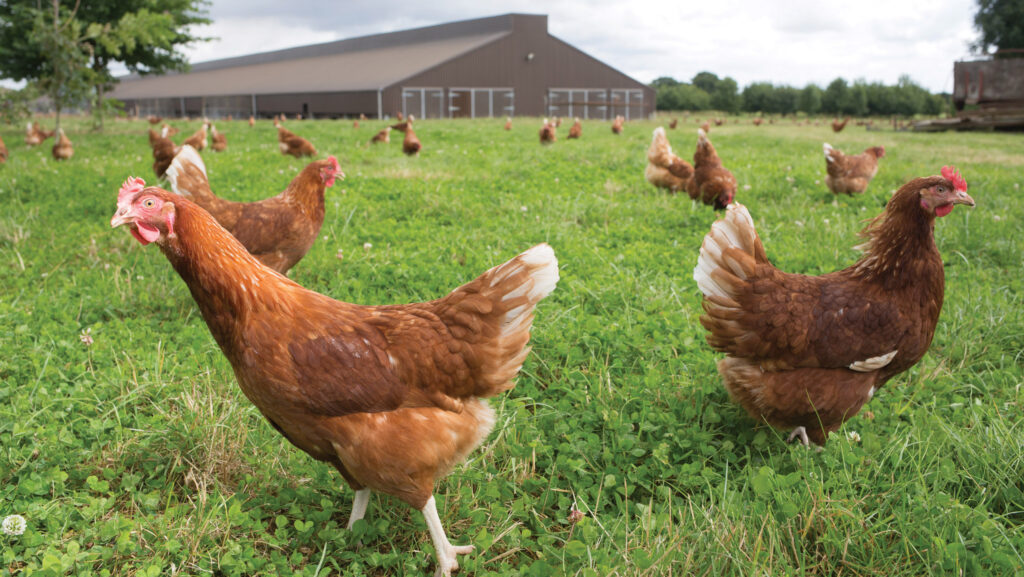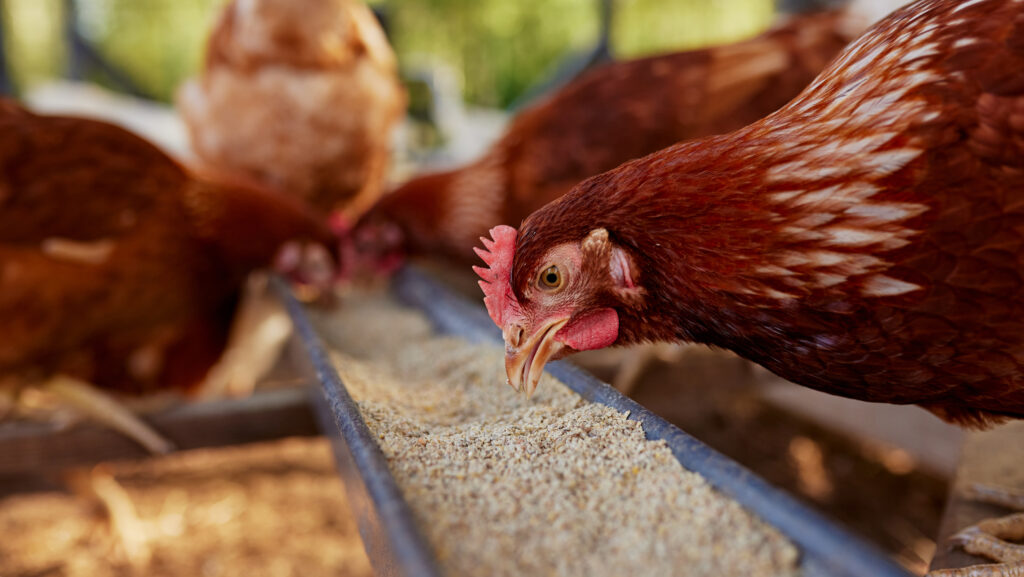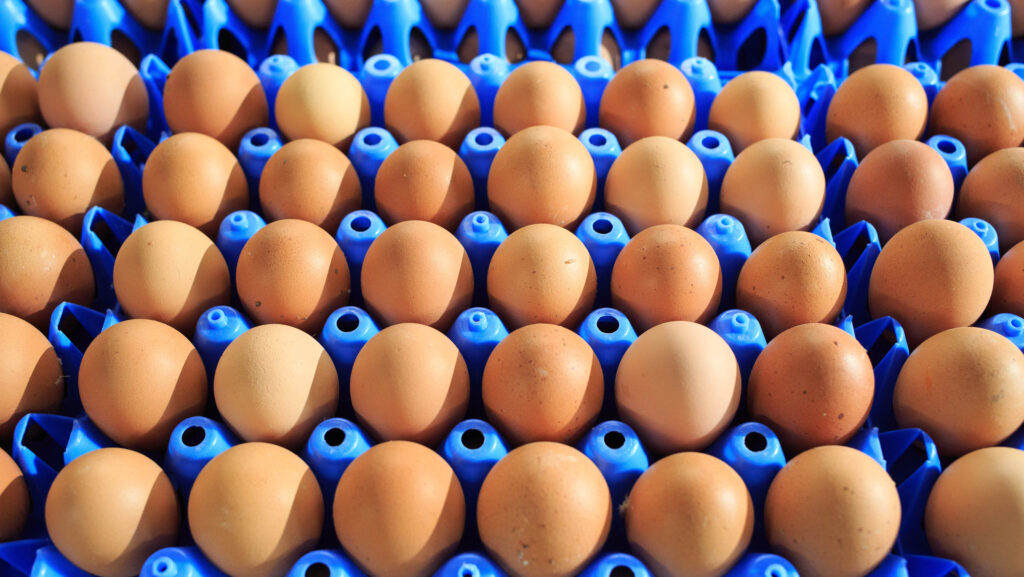Advice on free-range layer rations, stage by stage
 © Tim Scrivener
© Tim Scrivener From early chick development to transition into laying, feeding birds the correct nutrition at every stage will help achieve the best possible performance and egg quality.
Attention to detail is needed when formulating starter diets while providing feed that encourages intakes during the critical growth periods, according to poultry nutritionist Ralph Bishop.
See also: 4 tips for effective cleaning between free-range flocks
The goal is to get brown layers to 80 weeks and 380 eggs and white birds to 100 weeks and 500 eggs, he says.
Precision feeding – providing the correct types and quantities of feed (see “Typical rations for free-range layers at each stage of production”) from the moment a chick arrives on farm – will help achieve this.
Ralph, of Premier Nutrition, offers advice on how this can be delivered.
Chick starter ration
A ration high in energy and dense in amino acids will support early organ development, while calcium and phosphorus promote skeletal development – about 1% calcium and 0.5% digestible phosphorus.
Phytase enzymes that release phosphorus from phytate in cereals are vitally important for precise nutrition and to maximise nutrient efficiency.
Ensure feed of good physical quality (typically crumbs or 2mm pellets) is available when chicks arrive on farm, as consistent particle size and low levels of fines (not greater than 1mm) will encourage appetite.
Monitor crop fills for intakes in the first few hours on farm. Remember, if physical quality or feed management are poor, the bird will not eat enough feed to meet its requirements, whatever is specified on the feed ticket.
Ration at 10-16 weeks
The bird must learn to eat a high volume of feed ahead of transition into lay. Daily feed intake will lift from about 60g to 120g in an eight-week window after transfer to the laying house.
This ration is lower in energy and amino acids and should contain a high level of insoluble fibre.
The low-density ration encourages birds to eat a greater volume and build their crop and gizzard.
At the same time, the insoluble fibre makes them feel satiated and gives the gut physical structure to work on building muscle tone throughout the gastrointestinal tract.

© Adobe Stock
Ration at 16-30 weeks
Pullet rearing should be considered a 30-week job, rather than the traditional 16 weeks.
The bird is transitioning from an approximate body weight of 1.25kg with no egg production at week 16, to at least 90% egg production and an egg size of 60g or more, while its bodyweight needs to be more than 1.8kg by 28 weeks.
Daily consumption must rise significantly to support the corresponding increase in nutritional requirements.
The best transitioning flocks will have a daily feed intake of 100g at week 20/21. Flocks that only reach this at week 23/24 will achieve lower levels of longevity, productivity and profitability.
Oats, sunflower, beans, rapemeal and distillers’ dried grains with solubles (DDGS) supply insoluble fibre. This helps gut health (and gizzard development), which supports flock longevity by reducing levels of feather pecking and associated mortality.
It is better to have a best-value feed programme than focus on a least-cost approach with separate feed programmes for the rearing and laying parts of this period.

© Tim Scrivener
Ration for 30-50 weeks
From 30 weeks onwards, keep a proactive eye on farm data, particularly egg size, and discuss these with the flock’s team of specialist advisers.
Target an egg weight that aligns with the farm’s egg contract and gives the best opportunity for flock longevity and profitability.
There may be little benefit in producing a 67g egg over a 62g or 64g and it is very difficult to reduce egg size once established.
However, this can be controlled through reductions in balanced protein, methionine, added oil and linoleic acid in combination.
Ration for 50 weeks-plus
In later lay, consider calcium, phosphorus and vitamin D3 to maintain high shell quality and minimise second-grade eggs.
Increase the particle size of the limestone when practically possible.
Research has debunked the industry myth that more calcium is always better: there is an initial improvement in shell strength and thickness, but this reduces with further increases in calcium.
Supplementing with choline will support liver health.
Different molecular forms of vitamin D can help maximise the level of active vitamin in the shell gland that supports shell quality.
Typical rations for free-range layers at each stage of production |
|||
|
Raw material |
Starter ration (%) |
Ration – week 10-16 (%) |
Ration – week 16-30 (%) |
|
Wheat |
60 |
49.5 |
54.5 |
|
Barley |
5 |
25 |
10 |
|
Soya meal |
27 |
2 |
16 |
|
Rape meal |
0 |
10 |
0 |
|
Sunflower meal |
2 |
10 |
7 |
|
Soya oil |
2.5 |
0.5 |
2.5 |
|
Vitamins, minerals, amino acids |
3.5 |
3 |
10 |
Nutrient analysis |
|||
|
Oil |
4.25 |
2.5 |
4.75 |
|
Crude protein |
21 |
15.5 |
17 |
|
Fibre |
3 |
5 |
4 |
|
Ash |
5.5 |
5 |
12.25 |
|
Lysine |
1.15 |
0.75 |
0.9 |
|
Methionine |
0.5 |
0.35 |
0.45 |
|
Note: Rations in later lay typically contain lower levels of phosphorus and balanced protein alongside elevated levels of calcium to support shell quality and flock longevity. Source: Ralph Bishop, Premier Nutrition |
|||
Advice on drinking water quality
Stagnating water in poultry house water systems can be a breeding ground for bacteria that compromise flock health and performance. However, simple measures like regular flushing can prevent this.
Water is consumed at a rate that is nearly twice the intake of feed. A 16,000-layer flock, for example, will drink about 3,700 litres (3.7t) daily while eating 2t of feed.
Providing flocks with clean, potable drinking water will improve stability of gastrointestinal-tract microbiota, aid feed use, improve egg production and provide resistance to other disease challenges.
This will reduce the requirement for antibiotics, says Charles Macleod of veterinary business St David’s Poultry Team.
“Egg producers often underestimate the effect of suboptimal water quality, using hens to ‘filter’ the water, but that wastes their energy and increases the risk of secondary disease.”
The cause of contamination will depend on the water source and system, he adds: “Understanding the system from source to beak provides clues to the cause of any contamination and how to treat it.”
Contamination
Water can get contaminated as it travels through farm pipework from the main water meter to the poultry house, and even the cleanest private water supply can be adulterated.
“Flow rates decrease at the terminal ends of drinker lines, with water almost stationary in the last 12-18in [30-45cm], providing ideal conditions for bacteria to colonise,” Charles explains.
Protection of drinking water hygiene needs to be done on a site-by-site or even house-by-house basis, he suggests. However, some measures can work across all systems:
- Flush drinking lines as often as possible and ideally three times a day
- Record water consumption daily and plot on a graph to highlight any variances that require investigating
- Train staff to understand the importance of water and how the system works, covering protocols, procedure monitoring and equipment maintenance
- Keep detailed records of water quality tests, treatment measures and any incidents related to water supply or contamination
- Make routine water testing part of the flock’s ongoing health plan.
